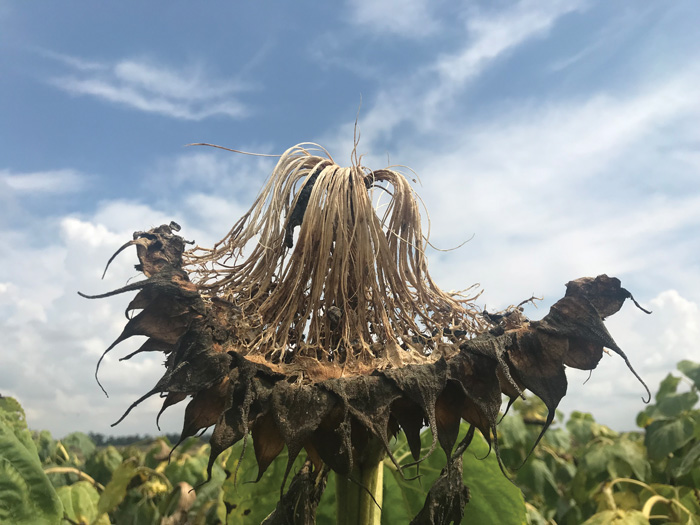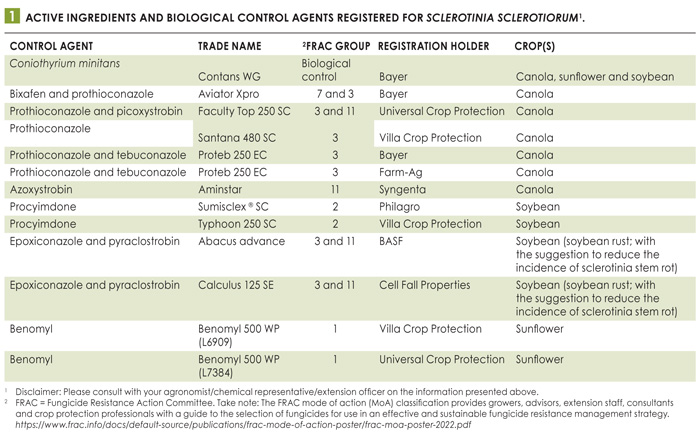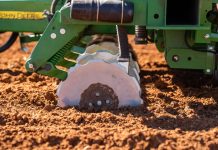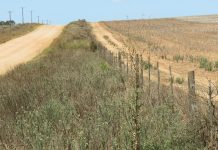
 Dr Lisa Rothmann, University of the
Dr Lisa Rothmann, University of the Free State
 Dr Miekie Human, Research and Policy Centre, Grain SA
Dr Miekie Human, Research and Policy Centre, Grain SAThe soilborne fungus, Sclerotinia sclerotiorum, is the causal agent of Sclerotinia diseases of canola, soybean, and sunflower. Sclerotinia stem and head rot diseases can cause severe damage and yield losses in the presence of inoculum (ascospores and mycelium) and under continuous wet and cool weather conditions.
These favourable weather conditions allow for the sclerotia to germinate and release inoculum, either in the form of spores, known as ascospores, or fungal threads, known as mycelium. Disease initiation and development are more likely in the presence of flowers and dying flower tissue, and when the plant canopy closes, as a favourable microclimate for the pathogen is created. At the end of the disease cycle the pathogen forms a survival structure, known as sclerotia, which can persist in the soil for multiple years.
Sclerotinia diseases can be managed through integrated pest management (IPM) which includes a combination of strategies to increase the chance of successful and effective disease management, such as agronomic, biological and chemical control. Cultural strategies include the use of healthy seed, limiting high plant populations, and avoiding high fertility and narrow rows. (This will be expounded on in the September edition through an article on Sclerotinia diseases and cultural control.)
Registered fungicides for the control of Sclerotinia stem rot during the season is, however, limited to canola and soybean, with only a seed treatment available for sunflower. Fungicides work to prevent flower petal infection by airborne spores of S. sclerotiorum – their effectiveness against direct infection by germinating sclerotia in the soil is unknown. It is important to note that chemical treatment is more efficient as preventative sprays rather than once symptoms have been observed. This article aims to provide tactics on biological and chemical control that can be useful in managing Sclerotinia diseases of oilseed crops, while taking into consideration environmental conditions.

Varying seasonal environmental conditions create complexities for Sclerotinia disease management. When considering fungicide application, the below considerations can be used in improving its efficacy of control in canola, soybean and sunflower:
- Seed treatments play an important role in protecting the seeds and seedlings from seed- and soilborne diseases and insect pests affecting crop emergence and its growth. Benomyl is a registered seed treatment for sunflower, but it has been taken off the market in certain countries due to the high toxicity. Should you make use of benomyl, please use with caution and use full protective wear.
- Flowering periods coinciding with extended rain events increase the risk of infection. Early applications at 15% to 30% bloom and ensuring that application has a good canopy penetration may limit disease development. Take note on how long the applied product remains active during these flowering periods, as the crop remains potentially vulnerable to Sclerotinia. The flowering period for canola is 60-69 days (~8-10 weeks), soybean is up to 42 days (~6 weeks) and sunflower up to 75 days (~8-11 weeks). Take note of the variety maturity group as that influences the duration of the flowering period.
- Active ingredients. Limit applications to two to four consecutive spray applications per crop per season (Table 1). The mode of action of fungicides determines how fungi will be affected by active ingredients and careful consideration of the FRAC group will delay fungicide resistance development and ensure longevity of chemistry available. See link on FRAC groups under Table 1.
- Label usage instructions. It is important to purposefully read and understand product labels when preparing and applying products. Products may require the addition of an adjuvant to enable greater spray droplet coverage on the plant to maximise the efficiency of the product. Take note of application instructions with regard to harvest withholding periods as chemicals have maximum reside limits (MRL) which are traces of active ingredients on the crop at harvest or even on food products.
- Recommended water volumes usage is important as it aids the fungicide in reaching the lower parts of the plants where airborne inoculum is more likely to initiate disease.
- Biological control with the fungus Coniothyrium minitans has been used successfully in smaller vegetable fields. It is, however, more expensive for field crops such as canola, soybean and sunflower. C. minitans parasitises sclerotia in the soil and degrades the melanin, reducing the successful germination of the sclerotia. C. minitans is commercially available as Contans WG® fungicide, which is sprayed on the soil prior to planting or onto crop debris at the end of the season.
 Who to contact:
Who to contact:
- Feel free to contact Dr Lisa Rothmann (CoetzeeLA@ufs.ac.za, 079 270 9691), Dr Miekie Human (miekie@grainsa.co.za, 067 016 9493) or Dr Godfrey Kgatle (godfrey@grainsa.co.za, 079 489 5966) for further information.
- Please contact us should you notice Sclerotinia in your field. This information will be important for surveillance and mapping the distribution of Sclerotinia diseases.
- For updates, visit the South African Sclerotinia Research Network (SASRN) website (http://sclerotinia.co.za/) or Facebook page (https://www.facebook.com/sclerotiniaZA).




























